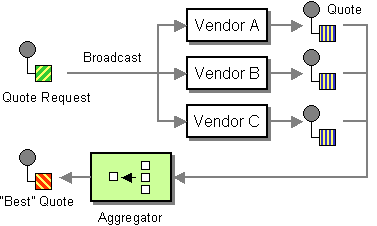Scatter-Gather
Camel supports the Scatter-Gather from the EIP patterns book.
The Scatter-Gather from the EIP patterns allows you to route messages to a number of dynamically specified recipients and re-aggregate the responses back into a single message.

In Camel, the Scatter-Gather EIP is supported in two different synchronous modes.
-
request/reply mode, where the re-aggregated response message continues being routed synchronously after the Scatter-Gather is complete.
-
one-way mode, where the response message is being routed asynchronous separately from the incoming message thread.
Request/Reply vs. One-Way messaging modes
In Camel, the request/reply mode is done by using only the Recipient List which comes with aggregation built-in (which is often the simplest solution).
The request/reply mode refers to the fact that the response message is tied synchronously to the incoming message (that would wait) until the response message is ready, and then continue being routed. This allows for Request Reply messaging style.
The one-way mode refers to the fact that the response message is not tied to the incoming message (which will continue). And the response message (when its ready) will continue being routed independently of the incoming message. This only allows for Event Message messaging style.
In the one-way mode, then you combine the Recipient List and Aggregate EIPs together as the Scatter-Gather EIP solution.
Using Recipient List only
In the following example, we want to call two HTTP services and gather their responses into a single message, as the response:
<routes>
<route>
<from uri="servlet:cheese"/>
<recipientList aggregationStrategy="cheeseAggregator">
<constant>http:server1,http:server2</header>
</recipientList>
<to uri="log:response"/>
</route>
</routes>This is a basic example that only uses basic functionality of the Recipient List. For more details on how the aggregation works, see the Recipient List documentation.
Using Recipient List and Aggregate EIP
In this example, we want to get the best quote for beer from several vendors.
We use Recipient List to get the request for a quote to all vendors and an Aggregate to pick the best quote out of all the responses.
The routes for this are defined as:
<routes>
<route>
<from uri="direct:start"/>
<recipientList>
<header>listOfVendors</header>
</recipientList>
</route>
<route>
<from uri="seda:quoteAggregator"/>
<aggregate aggregationStrategy="beerAggregator" completionTimeout="1000">
<correlationExpression>
<header>quoteRequestId</header>
</correlationExpression>
<to uri="direct:bestBeer"/>
</aggregate>
</route>
</routes>So in the first route, you see that the Recipient List is looking at the listOfVendors header for the list of recipients. So, we need to send a message like:
Map<String, Object> headers = new HashMap<>();
headers.put("listOfVendors", "bean:vendor1,bean:vendor2,bean:vendor3");
headers.put("quoteRequestId", "quoteRequest-1");
template.sendBodyAndHeaders("direct:start", "<quote_request item=\"beer\"/>", headers);This message will be distributed to the following Endpoints: bean:vendor1, bean:vendor2, and bean:vendor3. These are all Java beans (called via the Camel Bean endpoint), which look like:
public class MyVendor {
private int beerPrice;
@Produce("seda:quoteAggregator")
private ProducerTemplate quoteAggregator;
public MyVendor(int beerPrice) {
this.beerPrice = beerPrice;
}
public void quote(@XPath("/quote_request/@item") String item, Exchange exchange) {
if ("beer".equals(item)) {
exchange.getMessage().setBody(beerPrice);
quoteAggregator.send(exchange);
} else {
// ignore no quote
}
}
}And are loaded up in XML like this:
<camelContext>
<bean id="aggregatorStrategy" class="org.apache.camel.spring.processor.scattergather.LowestQuoteAggregationStrategy"/>
<bean id="vendor1" class="org.apache.camel.spring.processor.scattergather.MyVendor">
<constructor-arg><value>1</value></constructor-arg>
</bean>
<bean id="vendor2" class="org.apache.camel.spring.processor.scattergather.MyVendor">
<constructor-arg><value>2</value></constructor-arg>
</bean>
<bean id="vendor3" class="org.apache.camel.spring.processor.scattergather.MyVendor">
<constructor-arg><value>3</value></constructor-arg>
</bean>
</camelContext>Each bean is loaded with a different price for beer. When the message is sent to each bean endpoint, it will arrive at the MyVendor.quote method. This method does a simple check whether this quote request is for beer and then sets the price of beer on the exchange for retrieval at a later step. The message is forwarded on to the next step using POJO Producing (see the @Produce annotation).
At the next step, we want to take the beer quotes from all vendors and find out which one was the best (i.e., the lowest!). To do this, we use the Aggregate EIP with a custom AggregationStrategy.
The Aggregate needs to be able to compare only the messages from this particular quote; this is easily done by specifying a correlation expression equal to the value of the quoteRequestId header. As shown above in the message sending snippet, we set this header to quoteRequest-1. This correlation value must be unique, or you may include responses that are not part of this quote. To pick the lowest quote out of the set, we use a custom AggregationStrategy like:
public class LowestQuoteAggregationStrategy implements AggregationStrategy {
public Exchange aggregate(Exchange oldExchange, Exchange newExchange) {
// the first time we only have the new exchange
if (oldExchange == null) {
return newExchange;
}
if (oldExchange.getMessage().getBody(int.class) < newExchange.getMessage().getBody(int.class)) {
return oldExchange;
} else {
return newExchange;
}
}
}And finally, the aggregator will assemble the response message with the best beer price (the lowest). Notice how the aggregator has timeout built-in, meaning that if one or more of the beer vendors does not respond, then the aggregator will discard those late responses, and send out a message with the best price so far.
The message is then continued to another route via the direct:bestBeer endpoint.